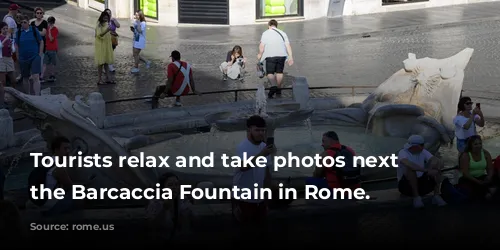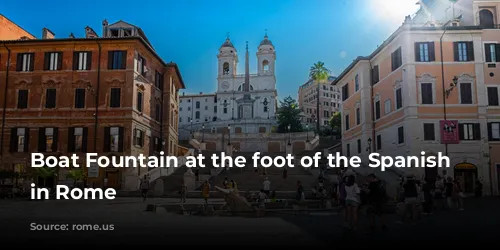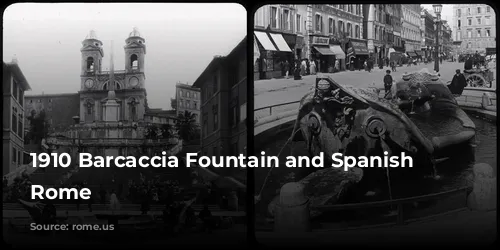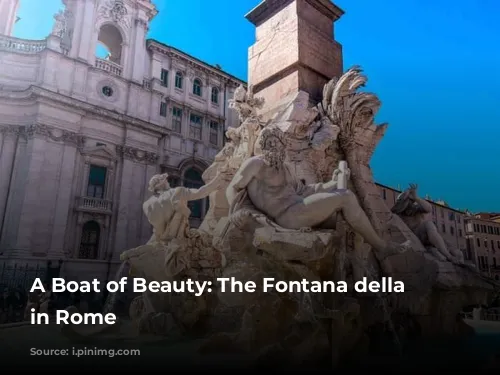Rome’s Piazza di Spagna, known for its elegant Spanish Steps, also boasts a unique treasure: the Fontana della Barcaccia. This captivating fountain, built between 1626 and 1629, tells a captivating story of art, history, and resilience.
Commissioned by Pope Urban VIII Barberini, the Fontana della Barcaccia was part of a broader effort to enhance Rome’s water infrastructure. The fountain is a testament to the city’s rich history and the ingenuity of its people.

The Story Behind the Fountain’s Shape
The Fontana della Barcaccia takes its name from the Italian word “barcaccia,” meaning “old boat.” This unique shape is inspired by a legend from the devastating flood of 1598, when the Tiber River overflowed, carrying a boat to Piazza di Spagna.
On December 25, 1598, the Tiber reached an unprecedented height of 19.56 meters above sea level. When the floodwaters receded, the boat was stranded where the fountain stands today. This tale of resilience inspired Pietro Bernini, the fountain’s architect, to design it as a semi-submerged boat.
Engineering and Design of the Fontana della Barcaccia
The fountain is fed by the Acqua Vergine aqueduct, built in 19 B.C. by Marcus Vipsanius Agrippa. While the aqueduct had been restored by Pope Urban VIII in 1623, it lacked the pressure needed for traditional fountains with high jets or waterfalls.
To overcome this challenge, Pietro Bernini, possibly with contributions from his son, Gian Lorenzo Bernini, designed the fountain to be slightly below ground level. This clever solution allowed the water to flow gracefully into the boat-shaped basin.
The water pours from a central basin and two giant sun-like sculptures, with additional jets emerging from faux gunboats on the sides. This design is a masterful blend of art and engineering, creating a captivating visual experience.
Beyond the Boat: Artistic and Literary Connections
The Fontana della Barcaccia’s innovative design is a departure from traditional geometric forms, showcasing a more sculptural approach aligned with the Mannerist artistic movement. The name “Barcaccia” itself reflects the theme of abundance, referring to the flat-bottomed boats used to transport goods on the Tiber River in the 17th century.
The fountain also holds a special place in literary history due to its connection with the poet John Keats. During his final months, Keats lived near the Spanish Steps, battling tuberculosis. He found solace in the sound of the flowing water, which inspired his epitaph.
Although Keats died on February 23, 1821, his friend Joseph Severn inscribed a more detailed epitaph on his tombstone. This inscription reflects Keats’ enduring legacy and the critics’ failure to recognize his genius during his lifetime.

A Timeless Landmark
For nearly 400 years, the Fontana della Barcaccia has enchanted visitors. Its design invites interaction, allowing visitors to drink from the Acqua Vergine water. The travertine platforms at the bow and stern provide convenient access to the refreshing jets.
The fountain’s enduring charm is evident in a 1910 photograph by G. Massiot & Cie, which captures the fountain from the perspective of the square. The image reveals how little the area has changed in over a century, highlighting the timeless beauty of this landmark.
Standing at the foot of the Spanish Steps, the Fontana della Barcaccia offers a picturesque setting for reflecting on Rome’s artistic heritage. Nearby landmarks like the Keats-Shelley Memorial House enhance the cultural significance of the area.
Today, visitors can marvel at how the Fontana della Barcaccia has become an integral part of the square’s life. This historical monument continues to enchant visitors from around the world, showcasing the enduring beauty of art and history.




